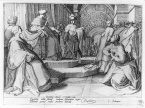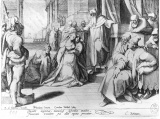Dossier:Painters and Drebbel: Difference between revisions
No edit summary |
No edit summary |
||
| Line 12: | Line 12: | ||
Others, such as Feeling (from the Five Senses) and the Seven Liberal Arts were made after Hendrick Goltzius. | Others, such as Feeling (from the Five Senses) and the Seven Liberal Arts were made after Hendrick Goltzius. | ||
Concerning [[:Category:Portrait|portraits]] of Cornelis Drebbel, there are only a few realistic ones. Most of them served as an illustration to his books. The first one was made in 1604 by another Gotlzius pupil [[http://www.dbnl.org/tekst/aa__001biog21_01/aa__001biog21_01_0017.php Christoffel van Sichem]]. Others are dated 1608 (Henrichen von Haestens's book), 1621 (slightly modified copy of van Sichem 1604) and 1628 (Burggrav's book). Furthermore there is Drébbel's selfportrait from Stolcius' Album Amicorum in 1623. All the other portraits seem to be artist impressions of the former. | {| | ||
|[[File:1604_Drebbel_portret.jpg|thumb|left|75px| Drebbel 1604]] | |||
|} | |||
Concerning '''<u>[[:Category:Portrait|portraits]]</u>''' of Cornelis Drebbel, there are only a few realistic ones. Most of them served as an illustration to his books. The first one was made in 1604 by another Gotlzius pupil [[http://www.dbnl.org/tekst/aa__001biog21_01/aa__001biog21_01_0017.php Christoffel van Sichem]]. Others are dated 1608 (Henrichen von Haestens's book), 1621 (slightly modified copy of van Sichem 1604) and 1628 (Burggrav's book). Furthermore there is Drébbel's selfportrait from Stolcius' Album Amicorum in 1623. All the other portraits seem to be artist impressions of the former. | |||
Revision as of 19:16, 27 July 2016
During his whole life Drebbel has had close contacts with painters and graphical artists.It all started around 1590 with his training time in Hendrick Goltzius studio. In that period Cornelis Corneliszoon van Haarlem together with Hendrick Goltzius, his good friend, the painter and writer Karel van Mander and other artists, started an informal drawing school that has become known in art history circles as the Haarlem Academy or "Haarlem Mannerists". Probably this was a very informal grouping, perhaps meeting to draw nude models, and certainly to exchange artistic views. As a result of their trips abroad, they were quite familiar indeed with the trends in Italy and elsewhere. Jacob de Gheyn II and Jacob Matham were active students in that period, as well as Claes Jansz Clock and Petrus Overraat. Drebbel must also have met Goltzius' teacher Dirck Volkertsz. Coornhert.
Van Manderen was at the origin of three of Drebbel's engravings:
Others, such as Feeling (from the Five Senses) and the Seven Liberal Arts were made after Hendrick Goltzius.
Concerning portraits of Cornelis Drebbel, there are only a few realistic ones. Most of them served as an illustration to his books. The first one was made in 1604 by another Gotlzius pupil [Christoffel van Sichem]. Others are dated 1608 (Henrichen von Haestens's book), 1621 (slightly modified copy of van Sichem 1604) and 1628 (Burggrav's book). Furthermore there is Drébbel's selfportrait from Stolcius' Album Amicorum in 1623. All the other portraits seem to be artist impressions of the former.
When Drebbel moved to England in 1604 Robert Peake the Elder was appointed picture maker to the heir to the throne, Prince Henry. Isaac Oliver had become a painter of James I's court, painting numerous portraits of the queen Anne of Denmark and Henry Frederick, Prince of Wales, and John de Critz held the post of Serjeant Painter to king James I of England whereas Marcus Gheeraerts became a favorite portraitist of James I's queen Anne of Denmark. We didn't find detailed accounts about their contacts with Drebbel but it seems quite probable that they have worked together. It is well documented for example that John de Critz painted "bravely" for court masques, dramatic spectaculars which required elaborate scenery and scenic effects, where Drebbel was also involved.
Among Drebbel's inventions, the Perpetuum Mobile was the one that attracted the attention of many draftsmen-scientists and painters. In the first years after its announcement the focus was laid on "technical drafts" giving an idea of its components and function. Our slideshow displays those from John Speed (1604), Antonini (1612), Heinrich Hiesserle von Chodaw (1607? or 1612), Thymme (1612), William Sanderson (?), Jakob Fetzer, Joachim Morsius.
Many painters on the other hand have shown interest in his inventions and represented or used it in their works.



